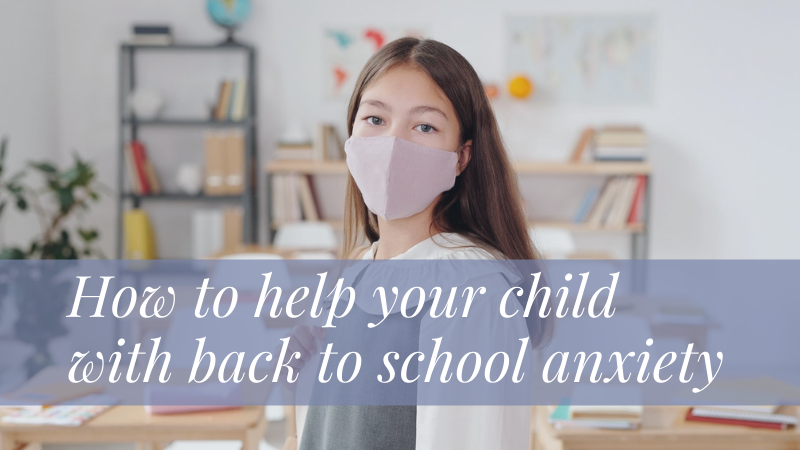Separation Anxiety
Children who are heading back to the classroom are facing unusual challenges, and one of them is anxiety about being separated from their families after months of togetherness. For some kids it will trigger separation anxiety, in addition to the anxiety, they may feel about leaving their safe shelter from the pandemic.
However, kids are really used to being home with their parents now. Even kids who had comfortably adjusted to being in school before the pandemic are finding it stressful to be separated now. And there is the added fear that other people are not as safe as we thought they were.
When kids go out now, they’re often reminded not to get too close to other people, to keep their masks on, to use sanitiser, and to wash their hands. There’s just anxiety in the air, and I think kids feel that. I think they are wondering: Are we sure it’s safe to go back? And are other people safe?
Struggles before pandemic
Another big factor that we need to take under consideration is that children who were struggling at school before the pandemic. For example, they didn’t like the environment, they found teachers too hard, or they felt rejected and excluded, they didn’t have friends, those children didn’t like school and they found it very hard to be there.
Those children maybe didn’t have good social skills developed before the pandemic, and when the restrictions were put in place and the schools were closed, those children felt a huge relief that they didn’t have to come back to the place they didn’t like.
However, they were given the alternative of online schooling. They didn’t have to be put out of their comfort zone. They were in a safe space and yet they got the education at the same time. It suited many children.
I think a lot of parents have been seeing some clinginess in younger kids, or even nine- or ten-year-olds. Kids are saying things like, ‘I don’t want to go back to school,’ or ‘I don’t want to be away from you.’ They’ve been out of the routine of going to school for so long it’s reasonable that they might struggle. And they might take a little bit longer to adapt, especially to these hybrid schedules.”
For some children, the excitement of going back to school after so many months stuck at home will outweigh potential anxiety. But I think the kids who already have anxiety are more prone to being more anxious going back.
So, parents have a complicated mission dealing with all this anxiety and uncertainty: reassuring children that it’s safe to be away from them, while also encouraging them to be careful and preparing them to be flexible in case the situation changes.
Validate their feelings
It’s worrisome when kids are clingy or fearful about separating from you, but it’s important for parents to stay calm and stay positive. If your child is telling you that they’re worried or having those negative feelings, you want to validate that and let them have some space to express that. But you don’t want to feed it too much and you want to help them think of something they can do about it.
Set the tone
The most important thought about going back to school is that parents lead the charge. If you deal with your own anxiety, you’re only going to fuel anxiety. So, you want to say what you know, answer questions and act calm even when you are not. Try not to ask leading questions “Are you nervous about going to school tomorrow?” Ask them about their emotions, acknowledge them but don’t be putting your own emotions onto them.
If children have questions you can’t answer, you can say, “That’s a really good question. I am not sure, but I can find out the answer to that question”. Kids appreciate knowing what you’re doing to manage the situation and also what they can do, so working together to ask and answer questions can help them stay calm.
Practice separating
For children who are anxious about being apart, our experts suggest practising separation, starting in small ways and building tolerance for more and more independence.
Things like playing in your room by yourself, while Mom is in the kitchen cooking dinner. Or staying with another caregiver while Mom or Dad goes out. Those little things build the currency towards the big separation.
Have a routine
Making sure that your child has a predictable routine leading up to school can help kids, especially younger ones, feel more secure.
And if your routine and practising separation still don’t prevent a child clinging to you at drop-off, it helps to have coordinated a plan with the teacher, so you know that when the teacher steps up to engage your child, and your child is even tentatively engaged, it’s the cue for you to go. As soon as the teacher gives you a signal that they have got it under control, even a tiny bit, you want to say, ‘Great job going with your teacher! See you later. Mommy is going to be back at noon’.
Encourage flexibility
Since there is a possibility that children who start school in person may be expected to switch back to remote learning, at least for some periods of time, it’s helpful for kids to know that you’re prepared for changes that may occur.
When should you get help?
Kids who have trouble separating often just need time, and support from parents and teachers, to adjust. But if your child is having severe meltdowns at drop-off time for more than two or three weeks and is unable to recover or to even stay at school, for more than three or four weeks, then seeking help can make a big difference.
Treatment for separation anxiety usually involves a therapist working with the child and the parents to plan step-by-step ways for them to practice separating a little at a time.
Moreover, therapists often work with teachers, too, to see what they can be doing to help and make sure they are on the same page with parents. Therapy also involves helping anxious kids talk to themselves and reassure themselves that they’re okay in difficult moments.
In some cases, kids may resist going back to school. Because the quarantine was actually a lot easier for them than going to school. Kids with a lot of social anxiety, or who were bullied, or kids with learning disorders who had an easier time at home where they could do things at their own pace. Therapists can explore with them what aspects of school they don’t like or don’t want to do.

